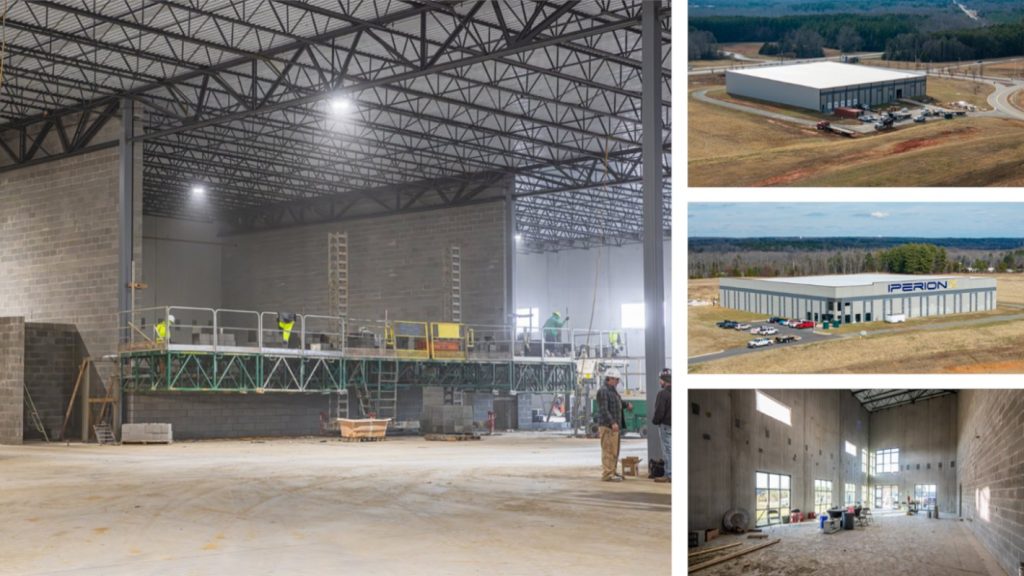North Carolina-based titanium developer IperionX has provided an update on the progress of its commercial-scale titanium metal manufacturing capabilities at the Titanium Manufacturing Campus in Virginia.
This development encompasses progress at both the Titanium Production Facility and the Advanced Manufacturing Center. The update’s highlight is the completion of the mechanical assembly and successful factory acceptance testing of the Hydrogen Assisted Metallothermic Reduction (HAMR) titanium furnace, a key asset for IperionX’s production efforts. Currently, en route from Europe to the Titanium Manufacturing Campus, this furnace is anticipated to be installed in Q2 2024.
“IperionX is nearing an important milestone designed to revitalize the U.S. titanium supply chain with a unique end-to-end solution that spans from recycled scrap titanium to high-performance forged titanium products. Our patented titanium technologies can produce a wide range of high-performance titanium products – including angular and spherical titanium powders, semi-finished titanium products, near-net titanium shape products and additively manufactured titanium components – with superior energy efficiency, lower costs, and lower environmental impacts,” said Anastasios (Taso) Arima, IperionX CEO.
Exploring IperionX’s patented technologies
Characterized by its large-scale industrial capacity, the HAMR titanium furnace incorporates proprietary technologies like HAMR and Hydrogen Sintering and Phase Transformation (HSPT), aimed at delivering sustainable, high-quality, and high-strength titanium metal products. The successful completion of factory acceptance testing underscores the company’s commitment to innovation and sustainability, potentially setting new benchmarks in the industry.
HAMR is a powder metallurgy technology developed by Dr. Zak Fang with funding from the U.S. Department of Energy’s (DoE) ARPA-E program. It enables the production of titanium powders from various feedstocks, significantly reducing energy intensity and carbon emissions. The main energy and emissions savings come from eliminating the need to chlorinate TiO2 for TiCl4 production and vacuum distillation after TiCl4 reduction. By using hydrogen to reduce oxygen levels in titanium powders, HAMR ensures high-quality output suitable for industry standards. This process transforms titanium oxide into low-oxygen titanium hydride, which can be further processed into titanium metal through standard methods.
HSPT is a powder metallurgy process developed by Dr. Fang and his team at the University of Utah. It allows for the low-cost production of near-net-shape titanium parts with properties similar to traditionally forged or wrought parts. Unlike traditional methods that require energy-intensive forging and machining, HSPT minimizes waste and costly post-processing. By combining powder metallurgy or additive manufacturing with HSPT, near-net-shape titanium parts with excellent properties can be produced economically and with reduced scrap generation.
Virginia facilities on track for mid-2024 operations
IperionX has also made significant strides in the construction of both the Titanium Production Facility and the Advanced Manufacturing Center. Construction progress remains on schedule for both facilities, with the Titanium Production Facility expected to commence operations and produce titanium metal by mid-2024. Similarly, the Advanced Manufacturing Center is slated for commissioning during Q2 2024.
Once operational, the Advanced Manufacturing Center will utilize angular and spherical titanium powders from the Titanium Production Facility. These will be used in conjunction with advanced techniques such as powder metallurgy, HSPT forging, and additive manufacturing/3D printing to produce a diverse range of low-cost and high-performance titanium products. To support government and customer engagement, the center will leverage CNC machining, post-processing equipment, and advanced R&D laboratories.
“We have a strong pipeline of potential U.S. government funding and incentive programs designed to re-shore and secure critical mineral and metal supply chains. The commissioning of our Virginia Titanium Manufacturing Campus will be a pivotal step forward, positioning IperionX with an innovative end-to-end titanium supply chain capable of manufacturing high-performance and low-cost titanium products for advanced American industries,” added the CEO.

Titanium 3D printing leaps forward
Titanium 3D printing allows for the creation of complex, lightweight, and strong parts, ideal for aerospace, medical, and diverse other applications. Back in 2022, Boeing collaborated with Titomic to advance aerospace using the Titomic Kinetic Fusion (TKF) 3D printing process.
Both companies investigated sustainable titanium powders for space systems, utilizing Australia’s local resources. This partnership aimed to demonstrate green titanium’s effectiveness in additive manufacturing, positioning Titomic as a key player in Australia’s space manufacturing sector.
Elsewhere, researchers from RMIT University and the University of Sydney developed strong, ductile, and sustainable titanium alloys, offering potential for cost-effective, high-performance materials in the aerospace, biomedical, and energy sectors. When integrated with Laser Directed Energy Deposition (L-DED) 3D printing, these alloys, utilize abundant materials like oxygen and iron, reducing reliance on expensive additives. Additionally, L-DED 3D printing enables precise control over alloy properties, achieving comparable strength and ductility to commercial alloys.
Published in Nature, the research aimed to replace aluminum and vanadium with oxygen and iron, addressing challenges in traditional titanium alloys. The collaboration also involved Hong Kong Polytechnic University and the Swedish software developer Hexagon’s Manufacturing Intelligence division in conducting the research.
What 3D printing trends do the industry leaders anticipate this year?
What does the Future of 3D printing hold for the next 10 years?
To stay up to date with the latest 3D printing news, don’t forget to subscribe to the 3D Printing Industry newsletter or follow us on Twitter, or like our page on Facebook.
While you’re here, why not subscribe to our Youtube channel? Featuring discussion, debriefs, video shorts, and webinar replays.
Are you looking for a job in the additive manufacturing industry? Visit 3D Printing Jobs for a selection of roles in the industry.
Featured image shows IperionX’s Titanium Manufacturing Campus in Virginia. Photo via IperionX.



